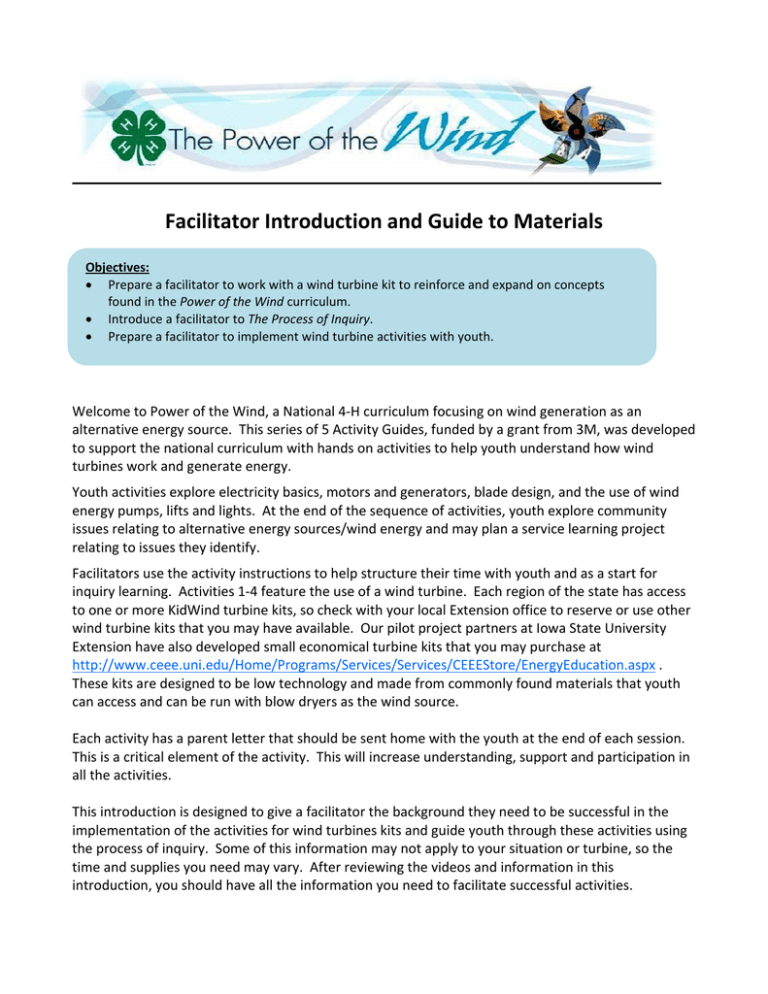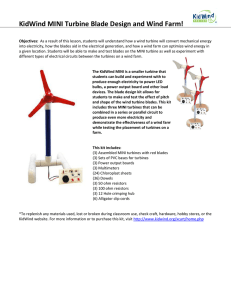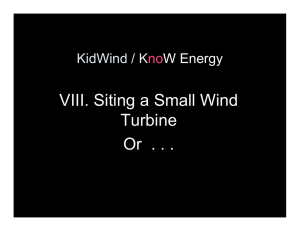
Facilitator Introduction and Guide to Materials Objectives: Prepare a facilitator to work with a wind turbine kit to reinforce and expand on concepts found in the Power of the Wind curriculum. Introduce a facilitator to The Process of Inquiry. Prepare a facilitator to implement wind turbine activities with youth. Welcome to Power of the Wind, a National 4‐H curriculum focusing on wind generation as an alternative energy source. This series of 5 Activity Guides, funded by a grant from 3M, was developed to support the national curriculum with hands on activities to help youth understand how wind turbines work and generate energy. Youth activities explore electricity basics, motors and generators, blade design, and the use of wind energy pumps, lifts and lights. At the end of the sequence of activities, youth explore community issues relating to alternative energy sources/wind energy and may plan a service learning project relating to issues they identify. Facilitators use the activity instructions to help structure their time with youth and as a start for inquiry learning. Activities 1‐4 feature the use of a wind turbine. Each region of the state has access to one or more KidWind turbine kits, so check with your local Extension office to reserve or use other wind turbine kits that you may have available. Our pilot project partners at Iowa State University Extension have also developed small economical turbine kits that you may purchase at http://www.ceee.uni.edu/Home/Programs/Services/Services/CEEEStore/EnergyEducation.aspx . These kits are designed to be low technology and made from commonly found materials that youth can access and can be run with blow dryers as the wind source. Each activity has a parent letter that should be sent home with the youth at the end of each session. This is a critical element of the activity. This will increase understanding, support and participation in all the activities. This introduction is designed to give a facilitator the background they need to be successful in the implementation of the activities for wind turbines kits and guide youth through these activities using the process of inquiry. Some of this information may not apply to your situation or turbine, so the time and supplies you need may vary. After reviewing the videos and information in this introduction, you should have all the information you need to facilitate successful activities. Facilitator Background Information: Extended Training Videos: These are actual recordings of a training workshop held for staff and volunteers who participated in the pilot stage of this program. These will give you the basics to wind turbine assembly and operation. They are located on the MN 4‐H Power of the Wind resource page along with all of the Activity Guides and materials: Introduction and the engineering process (29 Minutes) Turbine Assembly (KidWind specific) (12 Minutes) Conducting Investigations: The Inquiry Process (15 Minutes) FAQ’s videos: How much time do I need for activities? Inquiry learning and nacelle assembly Pick‐up: KidWind Adaptable Learning Turbine (ALT) kits or other Turbine Kit Supplies: Check supplies needed and the inventory. This will depend on the kit, but these are some common elements for most. Glue gun/glue Sandpaper Wire stripper Electric fan or other device to use for wind production and extension cords Screwdriver if needed. Electrical and duct tape Have spare parts. *Other resources: Iowa and Missouri POW pilot program partners have developed a series of videos that may be helpful as you prepare for your wind project. Check out the links on the MN 4‐H Power of the Wind resource page. Guide to Materials in the 5 Power of the Wind Activity Guides: All material is available on the MN 4‐H Power of the Wind resource page Activity 1: Electricity Basics Documents: Activity 1 Guide Parent Letter 1 Activity 1 Handouts Process of Inquiry Chart ALTurbines Instructions ‐ “How to Use the Multi‐Meter” http://www.kidwind.org/PDFs/CONSTRUCTION_ALTurbinev1.pdf Videos Electricity Basics (21 Minutes) Links National 4‐H Curriculum: http://www.4‐H.org/curriculum/wind How Can We Use Wind to Produce Electricity? KidWind ALTurbine Assembly and Activity Guide http://www.kidwind.org/PDFs/CONSTRUCTION_ALTurbinev1.pdf KidWind Mini Wind Farm Guide http://www.kidwind.org/PDFs/SUPPORT_PVC%20wind%20farmv2.pdf Activity 2: Motors, Generators and Capacitors Documents: Activity 2 Guide Parent Letter 2 Activity 2 Handouts Process of Inquiry Chart ALTurbines Instructions ‐ “How to Use the Multi‐Meter” http://www.kidwind.org/PDFs/CONSTRUCTION_ALTurbinev1.pdf Videos Motors, Generators and Capacitors (9 Minutes) FAQ’s Wire Management Questions on resistance Links National 4‐H Curriculum: http://online.4‐hcurriculum.org/curriculum/wind/ How Do Motors and Generators Work? Motors: http://www.wikihow.com/Build‐a‐Simple‐Electric‐Motor http://www.evilmadscientist.com/article.php/HomopolarMotor Generators: http://www.creative‐science.org.uk/gen1.html Activity 3: Blade Design Documents: Activity 3 Guide Parent Letter 3 Activity 3 Handouts Process of Inquiry Chart ALTurbines Instructions http://www.kidwind.org/PDFs/CONSTRUCTION_ALTurbinev1.pdf “Building and Attaching Blades” “Safety & Blade Testing Area” “Some Blade Building Tips” “Factors that Affect Power Output.” Videos Blade Design (13 Minutes) FAQ’s How high off the ground should the wind turbine be? Experimenting with different designs and variables Links National 4‐H Curriculum: http://online.4‐hcurriculum.org/curriculum/wind/ How Can We Think Like An Engineer? Learn More about Engineering Design Which Turbine Design is Better for the Job? What Innovative Design Can You Create? KidWind Wind Turbine Blade Design http://www.kidwind.org/PDFs/Blade%20Designv3.pdf Activity 4: Wind Turbines at Work: Pumps, Lifts and Lights Documents: Activity 4 Guide Parent Letter 4 Activity 4 Handouts The Process of Inquiry Chart AL Turbines Instructions ‐ “Powering items with your AL Turbine” http://www.kidwind.org/PDFs/CONSTRUCTION_ALTurbinev1.pdf Videos Wind Turbines at Work: Pumps, Lifts and Lights (8 minutes) FAQ’s More on pumps Links National 4‐H Curriculum: http://online.4‐hcurriculum.org/curriculum/wind/ How Can We Think Like an Engineer? How Can we Use Wind to Lift a Load? Which Turbine Design is Better for the Job? How Can We Use Wind Power to Produce Electricity? “How does a Windmill Work?” Lesson 6 http://www.windwiseeducation.org/ Activity 5: Wind Turbines in Our Community Documents: Activity 5 Guide Parent Letter 5 Videos Chasing a Legacy: the Story of Wind Power in Kittitas County http://wwnw.org/index.php?pg=lcl&cat=Kittitas The Wind Business
http://www.thefutureschannel.com/dockets/science_technology/wind_farming/ FAQ’s Assembly of a wind farm to charge a cell phone or iPod Links National 4‐H Curriculum: http://online.4‐hcurriculum.org/curriculum/wind/ What Causes the Wind? Community Wind Project Conclusion: Inquiry based learning, no matter the subject, takes purposeful intent and planning. Wind Power and the engineering process provide wonderful ways to initiate and reinforce the Process of Inquiry. Using the Process of Inquiry youth will have an opportunity to observe and wonder, question, develop hypotheses, plan and test, analyze and interpret, conclude and report, all the while reflecting and rethinking the stages throughout the activity. (See the Process of Inquiry Chart) Take the time you need to understand your turbine so that you can guide youth in their inquiry adventure into wind power. Wind power is a compelling and critical energy source that youth are excited about exploring, as technology and science, as well as a way that they can be involved in improving their world for the future. The inquiry process will engage youth to learn more about wind, as well as other potential energy sources, and to apply that process, and specific knowledge, to real‐world situations and applications. A note about the National Power of the Wind curriculum…
If you wish to explore the complete national curriculum check out these links or order a set of facilitator and youth guides from your local Extension Office. Links: Power of the Wind Youth and Facilitators Guides http://online.4‐hcurriculum.org/curriculum/wind/grabandgo.aspxsing There is also a nationally developed training to support the Power of the Wind curriculum that you may find helpful. The 4‐H Power of the Wind training guide is now available at Training Guide ‐ http://4‐
h.org/resources/staff/powtrainingguide.html . This guide is fully scripted to prepare facilitators to understand and implement The Power of the Wind national 4‐H curriculum. Grab‐and‐Go http://online.4‐hcurriculum.org/curriculum/wind/grabandgo.aspxsing activities are also available on this national site and are good for using with a club that is focusing on renewable energy or as activities in a camp environment. These include: Measuring Wind Speed; Design and build a Barometer; Air Pressure; What causes Wind?; Kites; Design and Build a Weather Vane; Discovery, Invention, Big Ideas, and Wind; Community Wind Project; and the Renewable Scavenger Hunt. Acknowledgements: This series of resources was developed by: Janet Beyer, Retired program leader, University of Minnesota Extension Wendy Rubinyi, instructional design specialist: wrubinyi@comcast.net Dr. Mike Lindstrom, executive director‐SciMathMN Dr. Gillian Roehrig, associate professor of curriculum & instruction, University of Minnesota Support for this resource was provided by the 3M Foundation. The 3M Foundation invests in tomorrow’s leaders to support the environment, energy solutions, and engineering. No endorsement of a commercial entity or its products is intended or implied. ©2010 Regents of the University of Minnesota. All rights reserved.
The University of Minnesota is an equal opportunity educator and employer.
For Americans with Disabilities Act accommodations, please call 1-612-626-1333 (V/TTY)





